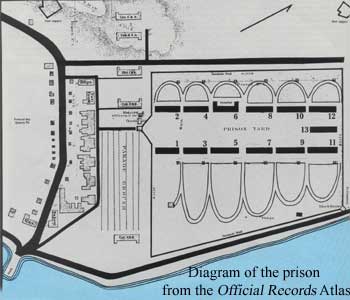Colonial Wars |
American Wars |
Link To This Page — Contact Us —
Johnson's Island Prisoner of War Camp
Search, View, Print Union & Confederate Civil War Prisoner of War Records, 1861-1865

Union 1862-1865
Sandusky, Ohio
Sandusky, OhioJohnson’s Island, located in Sandusky Bay, Lake Erie was chosen as the site for the Union depot of captured Confederate officers in late 1861. Johnson’s Island, approximately 3 miles from Sandusky, was determined to be conveniently accessible for supplies needed for construction and maintenance of the prison and its population. It was also considered more easily protected than other islands in the open lake. The island could be leased for $500 a year with the government having control over who had access to the island. Because of these advantageous factors, the Federal Government built a prison designed to hold 2,500 prisoners on the island.
From April of 1862 until September of 1865, over 10,000 Confederates passed through Johnson’s Island Prison.
Construction of the prison began on November 1861. It was estimated that the total cost of the prison would be around $30,000, including a blockhouse with a howitzer and a guardboat positioned offshore.
The compound was built on an already cleared area of almost 16 acres on the southeast end of the island. Stockade planks 14-feet tall were built around the site with the gate facing, and about 20-yards from, the shoreline. A platform was built along the top around the outside of the wall for the guards to use for patrolling. At the 2 corners facing the lake, blockhouses were built to house light artillery pieces. At the main entrance, another blockhouse was built.
The prison contained 13 Blocks, which were 2 stories high and approximately 130-feet by 24-feet. Of the 13 Blocks, 12 were used as prisoner barracks and 1 was used as the hospital. The inside of 4 of the barracks were divided into 22 rooms, 11 rooms on each floor. The other 8 barracks were divided into 6 large rooms, 3 on each floor. There were 2 kitchens to each barrack, built as additions to the main building. Inside each barrack was a wood-burning stove for heat during the winter months. Stairs led to the upper floors from the outside. The barracks for the guards and houses for the families of the Union officers were built 200-yards away from the prison. The officer barracks were on the west side and the guards' barracks were on the south and north sides. Another street ran behind the row of barracks, inside a series of stakes that served as the "deadline".
There were more than 40 buildings outside the stockade used by the 128th Ohio Volunteer Infantry to guard the prison. The 2 major fortifications (Fort Johnson and Fort Hill) protecting Johnson's Island were constructed over the 1864/65 winter, and were operational by March of 1865.
The Hoffman Battalion, which consisted of 400 men organized into 4 companies, formed the 128th Ohio Volunteer Infantry became the official guards of the prison until January 1864. At this time, 6 more companies were added and the Regiment was designated as the 128th Ohio Volunteer Infantry. The commandant was William S. Pierson, former mayor of Sandusky. Because of his cruelty to prisoners and his inability to handle problems and keep the prison in good order, he was replaced. On January 18, 1864 Brig. Gen. Harry D. Terry replaced Pierson. A few months later, on May 9, 1864, Col. Charles W. Hill took command at Johnson's Island, remaining as such until the end of the war.
The prison tookprisoners of all types, including officers, enlisted men, and civilian political prisoners until June 1862. After June, only Confederate officers would be held at the prison.
 |
LIFE & CONDITIONS:
As prisoners of war, they daily faced how to cope with their situation, whether to resist, to survive, or to assimilate by taking the Oath of Allegiance. Their choices resulted in a variety of activities taking place. Those contemplating escape spent time preparing, any idea took great planning and time to orchestrate. Some prisoners used their talents and limited resources to pass the time by carving rings, broaches, and other jewelry out of hard rubber, bone, and shell. Reading, especially newspapers was important to keep informed of the latest victories and defeats of the War, government actions, and news of exchanges.Prisoners could receive packages and mail. The mail was inspected and the parcels were searched and often damaged or depleted before the prisoner received them. Consequently prisoners often relied on the sutler store to buy sewing supplies, ink, stationery, clothes, food, combs, toothbrushes, etc. These items could be purchased until late in the war when food, along with other items, were no longer permitted to be sold by the sutler.
The prisoners on Johnson’s Island endured harsh winters, food and fuel shortages, disease, along with the mental anguish of uncertainty about their families and their own futures. Complaints of suffering from the extreme cold was one of the major complaints of the prisoners. During the winter when the well pumps froze, prisoners were allowed to the lake's edge to get their water. A special kind of recreation was used at the prison during the winter. Because of the abundance of snow, snowball fights became a favorite pastime.
The rats at the prison held the prisoners' undivided attention. Within a year of opening, the prison became another of several Union prisons where the catching and eating of rats became common practice for the prisoners in an effort to supplament their diet. In the beginning, rations were issued every day except on Sunday. Beef was issued 3 or 4 days a week and pickled pork was issued on the other days. Bread was issued every day and was baked at the prison. There was 1 loaf of bread for every 4 prisoners. As the prison population continued to grow, the daily rations continued to get smaller.
By mid-1864, the prison had become overcrowded and filthy. The trash piled up in the prison.
The prisons' latrines, or "sinks", were 18-feet long, 5-feet wide, and 5-feet deep, covered by sheds, at the rear of the barracks. There was always poor drainage at the prison because of the makeup of the ground.
During the prison's exictence, the health of the prisoners was generally good. The most prevaliant diseases were typhoid fever, pneumonia, and smallpox.
On September 23, 1864, a tornado ripped through the prison at 8:30 P.M. during a severe thunderstorm. The damage included nearly half of the prison fence being blown down, 3 Blocks were destroyed, a wing of the hospital was destroyed, trees all across the island were blown down, and a number of prisoners were huirt but none were killed.
At the end of the war there were about 3,000 Confederates in the prison, and it was not until September 5, 1865, that the last of them were transferred out. The prisoners were paroled out in alphabetical order. The last 6 prisoners were transferred out to Fort Lafayette and Fort Delaware in September 1865. After the prison closed, the buildings were dismantled, the lumber and other items sold off, and the land turned back over to Mr. johnson for farming.
There was only 12 successful escapes from the island during its existence as a prison. Being a major prison, there were many formal executions served out at the prison. There were a number of major Confederate plots to release the prisoners but none were successful.
After the Civil War, most of the buildings on Johnson’s Island were auctioned off. The land was used for farming, and quarrying started in the late 1800’s. The resort business began around then also, but eventually failed. Residential building began in the 1950’s allowing private residents to enjoy waterfront properties. In 1990, Johnson’s Island was designated as a National Historic Landmark recognizing its significance in the Civil War as one of the premier Union prisons. The Confederate Cemetery, located on Johnson’s Island is currently the only publicly available part of the prison. A portion of the prison compound and all of Fort Johnson have been set aside for long term preservation by the current landowner.
